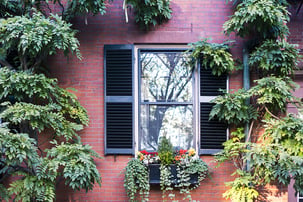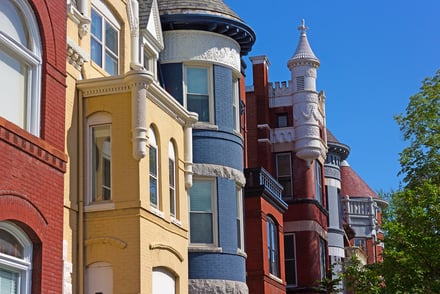There are many ways to increase the curb appeal of historic brick houses in DC and the warm spring and summer months are the best time to act. The home’s landscape, particularly the gardens in front, is an important element in creating a first impression for the rest of the property. Here are some tips for increasing the visual curb appeal of your historic house.
.png?width=200&name=Curb%20Appeal%202%20200%20x%20200(1).png) Check Out the View
Check Out the View
Cross the street and take a good, hard look at your front or foundation landscape. Try to see it as a first-time visitor. Pay attention to the plantings, the walkways and retaining walls. Does it seem to have balance? Plantings that are in proportion to the house will add harmonious shape and color to heighten the architecture. Well-tended shrubs and flowers define style - elegant to chic - and hint of well-designed and maintained interiors. Well-built retaining walls add to the look of a sturdy foundation while creating borders between the private garden and the public sidewalk.
Simplify and Remake Your Beds
Plants should frame the features of the house. Evergreens can easily get out of control, become  massive and take up garden space. Oversized plants that obscure the walkways or windows can be removed and replaced. Many older gardens have a hodgepodge of plants that create visual clutter. Weed out the tired plants and add new perennials to existing beds to add color and freshen the overall look.
massive and take up garden space. Oversized plants that obscure the walkways or windows can be removed and replaced. Many older gardens have a hodgepodge of plants that create visual clutter. Weed out the tired plants and add new perennials to existing beds to add color and freshen the overall look.
No space for ground plantings? Consider window boxes or decorative planters on your stoop.
Upgrade and Redesign Your Entry Way
.png?width=200&name=Curb%20Appeal%202%20200%20x%20200(2).png) Well-designed and maintained clay brick walkways and steps, in deep reds, oranges, and browns, create unique curb appeal for entryways. But crumbling or hazardous passageways become an eyesore that will detract from the appeal of even the most beautiful buildings. When front walks and entries get tired and need repair, it’s an opportunity to redesign. If possible, widen the walkways and add container gardens that enhance the home’s unique style. You will be able to change out those plants for seasonal interest.
Well-designed and maintained clay brick walkways and steps, in deep reds, oranges, and browns, create unique curb appeal for entryways. But crumbling or hazardous passageways become an eyesore that will detract from the appeal of even the most beautiful buildings. When front walks and entries get tired and need repair, it’s an opportunity to redesign. If possible, widen the walkways and add container gardens that enhance the home’s unique style. You will be able to change out those plants for seasonal interest.
Only Employ an Expert Preservationist for Repairs
We like to think there is a kind of stewardship involved in owning and caring for an historic brick .png?width=200&name=Curb%20Appeal%202%20200%20x%20200(4).png) home. While the temptation may be great to save money by performing “spot repairs” on your historic brick home, alleged cost-saving measures such as spot tuckpointing can actually cost more over time. Many brick masons are not knowledgeable about historic masonry practices and materials, and may use more modern mortar for spot repairs, without understanding the damage it can do.
home. While the temptation may be great to save money by performing “spot repairs” on your historic brick home, alleged cost-saving measures such as spot tuckpointing can actually cost more over time. Many brick masons are not knowledgeable about historic masonry practices and materials, and may use more modern mortar for spot repairs, without understanding the damage it can do.
Introducing new material into an older brick structure can place undue stress on the building, compromising its overall integrity and causing even more problems. Unless professional tuckpointing is performed by a trained and experienced preservationist, using the correct materials (based on the age and density of the bricks), the quick repairs will cause more cracks and spalling to occur.
Renaissance Development, a leader in brick restoration and historic preservation, specializes in the restoration of a historic brick building’s mortar joints using traditional methods (tuckpointing) and materials. Contact us for a free site visit and project quote.
Jun 9, 2022 8:30:00 AM


